Boletus L.
Recent molecular studies have shown that Boletus in its current circumscription is likely an artificial grouping and it is possible that it will be split at some point into smaller genera. Note that Boletus impolitus and Boletus depilatus for practical reasons are retained here, although there is strong evidence that they are closely related to Xerocomus subtomentosus and its allies.
Fruitbody large to medium sized, boletoid, without veil and ring. Stipe solid, with surface usually covered with granules or network. Flesh variously coloured, changing or not when exposed to air. Tubes easily separable from each other, not tearing apart. Pores usually small and rounded.
Boletus dupainii Boud.
Description
Pileus up to 9 cm, hemisperical, later flat-convex to convex, shiny, somewhat slightly viscid, reddish orange, vivid red to dark red, bluing strongly when bruised. Stipe cylindric club-shaped, club-shaped to swollen, yellowish white, more bright yellow nearly the apex, covered throughout with fine light orange, orange, reddish orange or pastel red granules; surface bluing when bruised or handled. Flesh lemon yellow, strongly bluing when exposed to the air. Tubes lemon yellow, bluing when injured. Pores bright red, orange to yellow nearly the cap margin, blue-black when bruised. Smell not distinctive. Taste not distinctive. Basidiospores 11–12 × 4.5–5.5 μm, ratio 2–2.7. Pileipellis (the cap cuticle) a trichoderm of interwoven branched septate hyphae of long cylindrical cells. Microchemical reactions: no reaction observed with Melzer’s reagent.
Habitat. Deciduous forests, mycorrhizal with oaks (Quercus).
Distribution. More or less southern species. Records are available from Austria, Bulgaria, Croatia, Germany, France, Greece, Hungary, Italy, Russia, Serbia and Montenegro, Slovakia, Slovenia, Spain, Switzerland and Turkey. Extraeuropean findings are known from the Russian Far East and North America, however these encounters need confirmation for conspecificity by molecular techniques. Boletus reichertii described from Israel seems very close to Boletus dupainii and needs further study.
Photographs
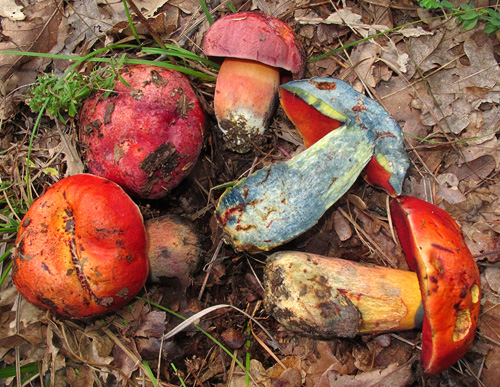
Ample collection of Boletus dupainii. Here and on the photographs below note the colour variability of this species. (photo G. Konstantinidis)
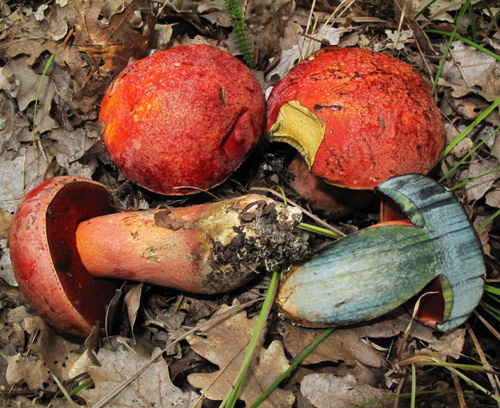
Fruitbodies of Boletus dupainii. (photo G. Konstantinidis)

Fruitbodies of Boletus dupainii in different stages of development. (photo G. Konstantinidis)
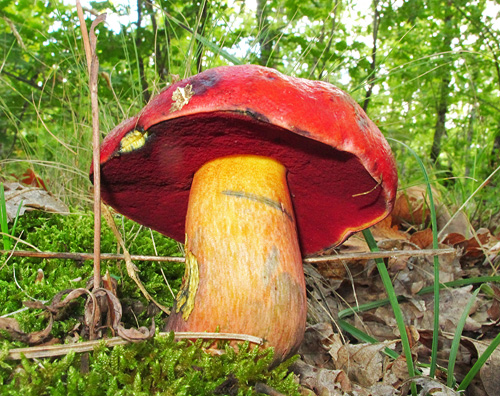
Fruitbody of Boletus dupainii. (photo G. Konstantinidis)
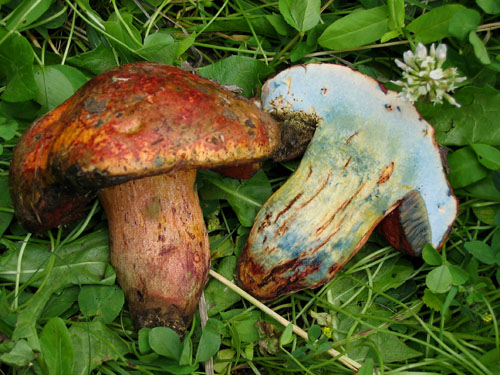
Fruitbody of Boletus dupainii. (photo B. Assyov)
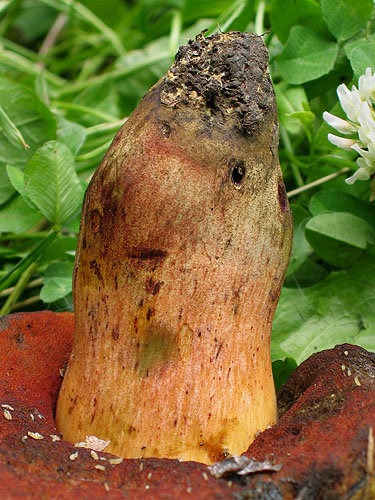
Boletud dupainii - detail of the granulated stipe surface.

Fruitbodies of Boletus dupainii. (photo L. Georgiev)
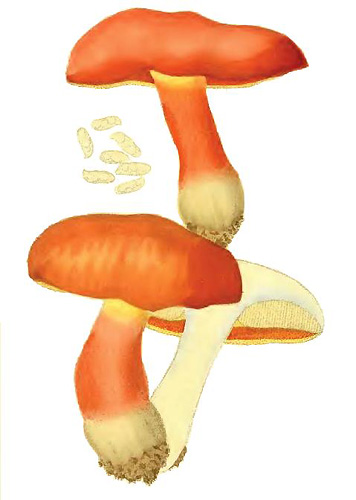
Boudier's illustration of Boletus dupainii accompanying the original description of the species.
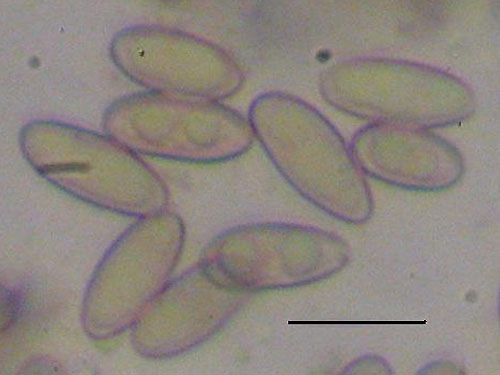
Spores of Boletus dupainii. Scale bar = 10 μm. (photo B. Assyov)
Important literature
Alessio, C.L. 1985. Boletus Dill. ex L. (sensu lato). – In: Fungi Europaei. Vol. 2. Pp. 1–705. Libreria editrice Biella Giovanna, Saronno.
Boudier, J.L.É. 1902. Champignons nouveaux de France. – Bulletin Trimestriel de la Société Mycologique de France 18: 137–146.
Breitenbach J. & Kränzlin F. 1991. Pilze der Schweiz. Bd. 3(1). Röhrlinge und Blätterpilze. Verlag Mykologia, Luzern.
Engel, H., Krieglsteiner, G., Dermek, A. & Watling, R. 1983. Dickröhrlinge. Die Gattung Boletus in Europa. Verlag Heinz Engel, Weidhausen b. Coburg.
Estadès, A. & Lannoy, G. 2004. Les bolets européens. – Bulletin Mycologique et Botanique Dauphiné-Savoie 44(3): 3–79.
Galli, R. 1998. I Boleti. Atlante pratico-monographico per la determinazione dei boleti. Edinatura, Milano.
Lannoy, G. & Estadès, A. 2001. Les Bolets. Flore mycologique d’Europe. Documents Mycologiques Mémoire Hors série no. 6. Pp. 1–163. Association d’Écologie et de Mycologie, Lille.
McConnell, O.L. & Both, E.E. 2002. Boletus dupainii in North America. – Field Mycology 3: 14–15.
Muñoz, J.A. 2005. Boletus s. l. – In: Fungi Europaei. Vol. 1. Pp. 1–951. Edizioni Candusso, Alassio.
Pilát, A. & Dermek, A. 1974. Hríbovité huby. Československé hríbovité a sliziakovité huby (Boletaceae – Gomphidiaceae). Veda, Bratislava.
Šutara, J., Mikšík, M. & Janda, V. 2009. Hřibovité houby. Čeled’ Boletaceae a rody Gyrodon, Gyroporus, Boletinus a Suillus. Academia, Praha.